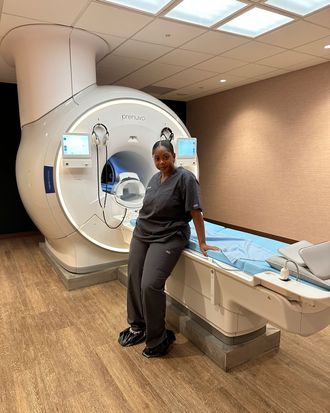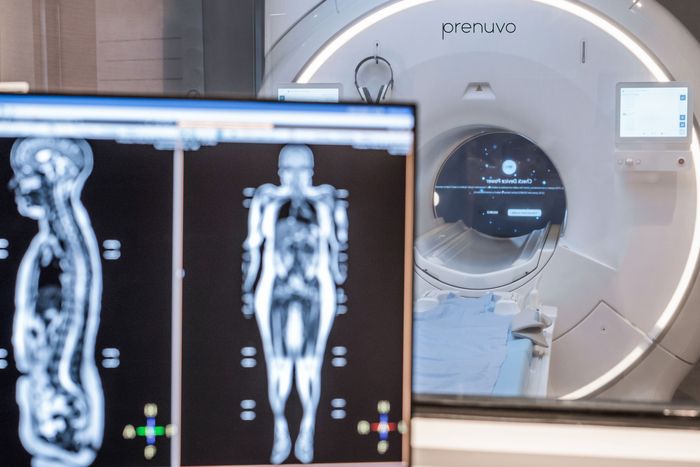
You might’ve seen Kim Kardashian try Prenuvo, a full-body MRI scan said to detect serious illness. (Her mom, Kris Jenner, has also tried it.) While it may seem like a buzzy Kardashian-Jenner-approved new wellness movement that has a very expensive price tag, they want to be seen as more than that. “We want you to be informed so you can advocate for your own health,” Andrew Lacy, founder and CEO of Prenuvo tells us. The clinics opened their doors in 2018, but recently (probably thanks to a slew of celebrities and influencers who have posted about it) more people are curious about Prenuvo.
I tried the scan myself to understand the hype. The question I kept getting asked most was: Are you scared to see what they find? I wasn’t. I jokingly told my friends that the body part I was most interested in learning more about was my liver because I drank a lot in my early and mid-20s. But, with a family history that is mostly healthy, I wasn’t too concerned about what would pop up. I was more intrigued about what the scan actually was and how this MRI would differ from any other MRI I’ve experienced. (In the past, I’ve had an MRI on the lower half of my body for a fracture in my leg.) It was certainly different, here’s how:
What is Prenuvo?
The 60-minute scan is said to be “a preventative health measure.” Basically, it’s three different MRI scans: a torso scan, a head-and-torso scan, and a full-body scan, the most comprehensive of them all. The MRI scan is said to access your anatomy by using image sequencing, to detect any signs in the body like inflammation that could be early detection of life-threatening diseases. A full-body scan to take images of the nervous system, respiratory system, reproductive system, digestive system, and more that are later evaluated.
The way the scan detects irregularity is by looking at inflammation in the body. “The relationship between inflammation and cancer is well-established in medical science. Certain cancers like helicobacter pylori-infected gastric cancer and human papillomavirus-related cervical cancer directly result from inflammation while others have higher incidence in people with inflammation. Our bodies deal with inflammation by producing high levels of reactive oxygen that can damage cells and at the same time promote cell-proliferation,” Lacy says.
How much about my body is too much to know? I found myself constantly asking. But, with the current state of our health care in America, especially as a Black woman who often has to advocate for myself at the doctor’s office, there was a perceived sense of calm knowing that there are options available if I have questions about my body that aren’t being answered.
What actually happens during the Prenuvo scan?
Before heading in to do my scan, I was emailed a medical assessment a few days before that asked for the medical history of my parents and grandparents, as well as their ethnicities and a laundry list of other health questions relating to personal health like allergies, previous illnesses, and more. On the day of my scan, I fasted for four hours prior to my arrival so there was no food in my digestive system that would cause any confusion in the scans. (Unfortunately even after fasting my food didn’t digest well so it popped up as a minor finding in my digestive system.) Once I arrived at the Prenuvo facility for my scan, I was checked into a room where I changed into scrubs and took off all jewelry and clothes, just like any other MRI. When I entered the scanning room I was greeted by a large, circular MRI machine. I am not claustrophobic in any way, but if I was, at first look I’d probably get a little anxious to enter the machine. I took a photo next to the machine honestly only because I saw Kim Kardashian and other people online do it.
Before entering the scan I was given the option to choose a Netflix show or movie, which was probably my favorite part of the scan because it made the hour go by a lot quicker. After that, the scanning technician comfortably set me up on the scanning table and gave me a panic button to hold. I was also given headphones to listen to my show of choice and to hear the technician throughout the scan. Then I was directed to breathe in and breathe out while holding my breath for a few seconds: “When you’re breathing, your diaphragm is pushing up and down on your abdomen, so the organs that you have in your abdomen are getting squeezed every time you breathe in and out. We want you to hold your breath out so that your lungs become quite small and we have a really clear visualization of your abdomen,” Lacy says. There were a few times my images had to be retaken because my breath holds were wrong. In the final ten minutes of the scan it got a bit warm, and that is when the countdown in my head started thinking, I think I’m ready to be out of this machine. Once the scan was done I was given some snacks and water. Then it was the waiting game.
My results were emailed to me about 48 hours later, and it brought me to a screen with the visual of a body categorized under different body systems. Some said “no adverse findings,” while others read “one informational finding,” which was interesting information they found that I should know, but nothing alarming. For instance, it showed me the lining of my uterus was thick, but for someone who was premenstrual, that was normal. Under my digestive system I saw “two minor findings,” and my anxiety immediately kicked in. When I opened it I almost chuckled because just as I guessed, my liver was tagged as one of the minor findings. It didn’t show me an image (some of the results show you your scanned images), but it gave me a message that “there is evidence of mild fat deposition in your liver,” which of course is a finding that can come with excess drinking. Now what? I thought. Prenuvo doesn’t connect you to medical professionals to treat any findings, but after every scan you have a 15-minute consultation with a nurse practitioner who walks you through your results (somewhat). After my call I felt at ease because I was told that my chart was pretty great and that the liver finding was extremely mild and reversible. Bagum Gulshad, a nurse practitioner for Birch Medical (a Prenuvo partnering agency), walked me through the informational findings: “Mild is a good term,” Gulshad said, referring to my liver findings. She also told me what could lead to these findings, such as alcohol intake, but reassured me that there were no signs of lesions or tumors. After that I was all on my own if I wanted any further information or additional tests on any findings. I was given no referrals to doctors or specialists following the appointment.
Would I try Prenuvo again?
Probably not. People who have numerous findings will find in their Prenuvo account on the website that a follow-up appointment for another scan is already scheduled for as soon as six months from their scan. For me, it scheduled me for another one a year from my first scan, which is a good sign, although I don’t think I’d do it in another year since it didn’t give me any information that I didn’t already know.
How much is Prenuvo?
For a full-body scan, the price is $2,499. Like most high-priced wellness tools, it is an investment, one that is often out of league for low-income communities who are highly likely to become ill due to environments. For a 45-minute head-and-torso scan, the price is $1,700 and a 20-minute torso scan is $999. While both other options are still extremely pricey, they’re certainly not close to the price of the full-body scan. If Prenuvo suggests going back in a few months because of any abnormal findings, the price remains the same. Any additional testing is not covered. Yet another reminder that health care in the United States is outrageously expensive, especially if it is “preventative.”




